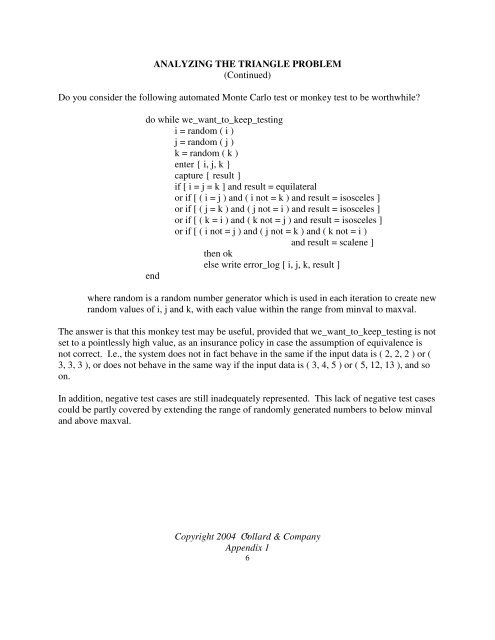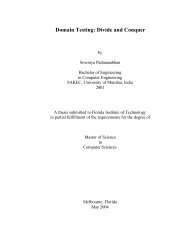appendix 1. analyzing the triangle problem - Testing Education
appendix 1. analyzing the triangle problem - Testing Education
appendix 1. analyzing the triangle problem - Testing Education
Create successful ePaper yourself
Turn your PDF publications into a flip-book with our unique Google optimized e-Paper software.
ANALYZING THE TRIANGLE PROBLEM<br />
(Continued)<br />
Do you consider <strong>the</strong> following automated Monte Carlo test or monkey test to be worthwhile?<br />
do while we_want_to_keep_testing<br />
i = random ( i )<br />
j = random ( j )<br />
k = random ( k )<br />
enter { i, j, k }<br />
capture { result }<br />
if [ i = j = k ] and result = equilateral<br />
or if [ ( i = j ) and ( i not = k ) and result = isosceles ]<br />
or if [ ( j = k ) and ( j not = i ) and result = isosceles ]<br />
or if [ ( k = i ) and ( k not = j ) and result = isosceles ]<br />
or if [ ( i not = j ) and ( j not = k ) and ( k not = i )<br />
and result = scalene ]<br />
<strong>the</strong>n ok<br />
else write error_log [ i, j, k, result ]<br />
end<br />
where random is a random number generator which is used in each iteration to create new<br />
random values of i, j and k, with each value within <strong>the</strong> range from minval to maxval.<br />
The answer is that this monkey test may be useful, provided that we_want_to_keep_testing is not<br />
set to a pointlessly high value, as an insurance policy in case <strong>the</strong> assumption of equivalence is<br />
not correct. I.e., <strong>the</strong> system does not in fact behave in <strong>the</strong> same if <strong>the</strong> input data is ( 2, 2, 2 ) or (<br />
3, 3, 3 ), or does not behave in <strong>the</strong> same way if <strong>the</strong> input data is ( 3, 4, 5 ) or ( 5, 12, 13 ), and so<br />
on.<br />
In addition, negative test cases are still inadequately represented. This lack of negative test cases<br />
could be partly covered by extending <strong>the</strong> range of randomly generated numbers to below minval<br />
and above maxval.<br />
Copyright 2004 Collard 6 & Company<br />
Appendix 1<br />
6








